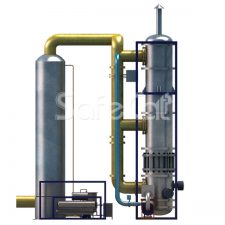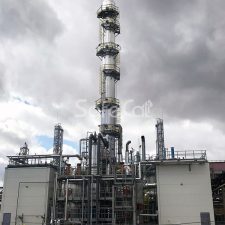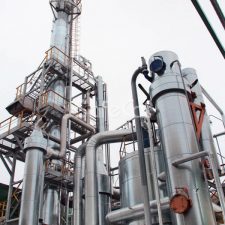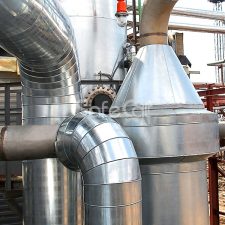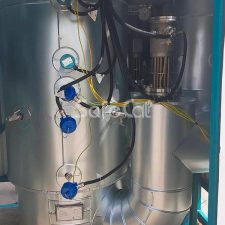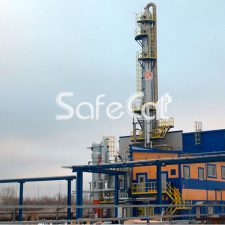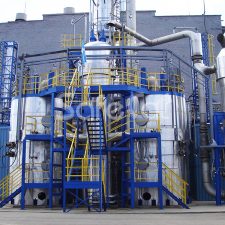Catalytic Technologies for Gas Emissions Purification. The Article in Journal ‘Oil. Gas. Novation’
Industrial enterprises processes are large sources of hazardous substances emission into the atmosphere. Among them are carbon monoxide, nitrogen oxides, and volatile organic compounds (VOCs).
The use of catalytic technologies is one of the most effective practices to combat. In Russia, this direction is yet young.
Safe Technologies together with the Boreskov Institute of Catalysis implements a comprehensive project with financial support of the Ministry of Education and Science of Russia to establish highly efficient catalytic systems for environment protection. Production of domestic plants based on proprietary platinum catalysts will solve the problem of import substitution and localization of production, provide Russian enterprises with affordable technology to purify emissions from VOCs, and expand the export potential of the Russian Federation.
Experts of ST Inc., Olesya Epinina, Head of the Ecology Department and Arkadiy Smirnov, Head of Technical Innovation Department, spoke about the project being implemented.
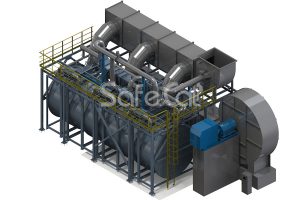 What is the innovativeness of the project ‘Highly efficient catalytic plants for environmental protection’, which is being implemented as part of Decree of the Government of the Russian Federation of April 9,2010 No. 218?
What is the innovativeness of the project ‘Highly efficient catalytic plants for environmental protection’, which is being implemented as part of Decree of the Government of the Russian Federation of April 9,2010 No. 218?
Arkadiy Smirnov: There is no batch production of equipment for purification of exhaust gases from organic matter in Russia. Our enterprises are accustomed to using flare and waste vent systems – an outdated method in terms of environmental safety and energy efficiency.
SafeCAT (SC) plants, that we are developing, when introduced into the production processes of enterprises with large flows of emissions, will increase their environmental safety as a whole.
To date, in addition to creating a platinum catalyst, other components have been developed and tested, making SC plants unique: rotor concentrator for low-concentrated VOC emissions, plate heat exchanger. R&D production base was also organized, equipped with stands on which tests of prototypes of components and equipment for the production of catalyst cartridges are carried out. A patent for a utility model was obtained and three applications for new patents were filed.
What applies to VOCs and where do they form? Which enterprises will benefit from the plant?
Arkadiy Smirnov, Olesya Epinina: Volatile organic compounds (VOCs) are the common name for many classes of substances, united, in fact, by one sign – they have increased volatility. Accordingly, during the industrial process, VOCs go into a gaseous state, evaporate and then are removed either by special or general ventilation.
VOCs are generated at the enterprises of paint and coatings, woodworking, and pharmaceutical industries. However, of course, the target market is the chemical and petrochemical industry, the production of rubbers, polymers, plastics.
When using the plant, the exhaust gases from reactors with sufficiently high concentrations of hydrocarbons are diverted to the processing by the catalytic method. In addition to the direct processes of the organic compounds production, formaldehyde emissions are generated, for example, in the production of resins, where they are perfectly treated by the catalytic method.
Partially, the catalytic method can be used at plastic processing enterprises, where hot materials release VOCs, but such enterprises are usually not very large. Here it may be difficult to collect the emissions for catalytic treatment.
Another example from the chemical industry is the production of maleic anhydride, which is an ideal application of catalytic technology, as the content of combustible organic matter in the exhaust gases is such that the temperature rise in the reactor is approximately 300 °C. It is safe for the catalyst and ideal from the point of view of economics of the process management and the utilization of the generated heat.
The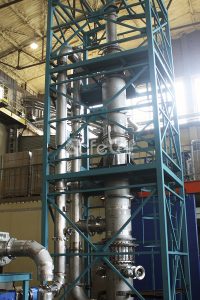 re is a range of gas purification technologies. What is the advantage of your method?
re is a range of gas purification technologies. What is the advantage of your method?
Arkadiy Smirnov: Indeed, there are a number of different gas purification technologies based on physical, physicochemical and chemical methods. Each of them has advantages when used on gas streams with different composition. The catalytic method does not affect solid impurities at all, but it can remove various organics from the gas stream, which are contained in sufficiently low quantities, making it economically impractical to use the thermal oxidation method.
The advantage of the catalytic method is that it practically does not require the supply of heat, constant consumption of fuel or another energy carrier to support the process. There is an optimal range of the content of organic substances in the flow (2–20 g/m3), within which the ongoing process does not require energy supply. In this case, the heat generated during the reaction is sufficient to heat the feed gases, start and maintain the process in an autothermal mode.
Another advantage is that almost any organic matter can be used for catalytic oxidation treatment – from simple alkanes to rather complex cyclic compounds, since the developed SC catalyst is a universal oxidation catalyst that is not selective. It, in general, does not care what the structure of the organic compound is. The result of the reaction is still water, carbon dioxide and other higher oxides, which are much safer than the starting compounds, and can be released into the atmosphere without harming the environment.
The advantages of the catalytic method include the low temperatures of the process. If we compare this method with thermal combustion, where the specific process temperature is quite high (900-1200°C), then in the case of catalytic neutralization, the initial temperature fluctuates from only 120 to 300°C and rises during the catalytic oxidation by a certain amount, which depends on the concentration of organic matter in the incoming gases.
As a standard, this heating is 300-400°C; accordingly, the maximum process temperature does not rise above 650- 700°C. This brings with it such positive aspects as the absence or strong reduction in the formation of nitrogen oxides compared with direct combustion.
In addition, the low temperature and the self-provision with a fuel resource from the composition of the initial gases can significantly save fuel or other heat source for reheating and maintaining the operating mode, i.e. we are dealing with a self-sustaining process.
Catalytic oxidation is less likely to cause explosions in any emergency, because in some cases the gases are not combustible on their own and, passing them through the catalyst, we achieve oxidation, but do not create explosive mixtures along the path.
Catalytic methods are cheaper by saving on investment and operating costs. When using higher temperatures, lining of the plant with refractory materials is required, and at low temperatures of the process, lining (expensive item of cost) is not required and cheaper metal can be used.
What is the composition of the main discharges neutralized by the SC?
Arkadiy Smirnov, Olesya Epinina: It all depends on the initial composition of the incoming gases, but in any case, in addition to the initial composition, nitrogen and residual oxygen — the remnants of the air that we add to oxidize hazardous substances — will be present at the outlet. If the initial stream itself contains a sufficient amount of oxygen, then in comparison with the incoming stream it will contain less oxygen, more carbon dioxide and water, the same amount of nitrogen and other inert gases that entered the reactor.
The oxidation efficiency of any substances does not reach 100%, it usually amounts to 99.5%, and however some small concentration of the starting substance or its derivatives will be contained at the output. This is determined by the composition of the pollutants supplied for oxidation.
It should be understood that during catalytic oxidation, the catalyst itself is not consumed, just the organics enter the reactor, oxidize to CO2 and H2O, and some very small part of the initial organics is thrown into the pipe.
Are there technologies for the purification of industrial emissions with a low concentration of harmful substances?
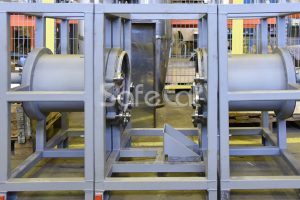
Arkadiy Smirnov: Catalytic oxidation technologies require the maintenance of a certain concentration of organic substances in the input stream in order to ensure the maintenance of the thermal mode in the process. For example, the concentration of organic substances in the ventilation emissions of the workshop is small, but the annual gross emissions are significant. In this case, the concentration of organic substances in the stream for purification increases artificially.
The first way is to add some kind of combustible substance, for example natural gas, into the general stream. This will ensure the desired thermal mode in the reactor. The downside is the high fuel consumption.
The second way is to use hardware concentrators. As part of R&D, we have also developed a rotor concentrator that will provide the processing of gas streams with a concentration of pollutants of only 0.02 g/m3. This concentrator is a continuously operating adsorber in which several sections are distinguished: a section for the adsorption of hazardous substances, a regeneration section, and a sorbent cooling section.
We pass the initial polluted stream with a high flow rate and a low concentration of pollutants through one of the sections of the concentrator, and then we regenerate the sorbent by heating it with a stream with a significantly lower flow rate. In this case, the process temperature is matched so that all absorbed substances are released back into this heated stream.
Due to the difference in costs herewith the same mass flow rate of the pollutant, we increase the concentration in the regenerated stream from 3-5 to 100 times or more, depending on the ratio of costs and the design of the concentrator. In the future, the stream can already be processed by the standard catalytic method with maintaining the process temperature due to the heat released in the reactor.
What are the advantages of catalytic oxidation over sorption?
Arkadiy Smirnov: In the case of sorption, a hazardous waste is always generated – the waste contaminated sorbent, which must be treated or landfilled in large volumes. In catalysis, waste is a safe spent catalyst that does not contain any contaminants. It is simply a catalyst that has lost activity, and the volume of waste generated is relatively small.
In addition, the sorbent at sufficiently high concentrations of pollutants requires frequent change or regeneration, and the catalyst works for the entire service life without any additional costs for maintaining efficiency.
That makes sense to go to the catalyst of your production. What is the advantage of your platinum catalyst?
Arkadiy Smirnov: If we are talking about ordinary platinum catalysts, then the share of the price of the catalyst in the price of the plant can be from 30 to 70% due to the high platinum content. Catalysts of ST production contains significantly reduced platinum amount, which reduces the cost of the plant and further operating costs. In this case, the efficiency remains at the level of classic catalyst samples, and in some cases exceeds the efficiency of analogues.
How did you manage to achieve this?
Arkadiy Smirnov: Classical catalysts are a carrier on which platinum is deposited: in the metal or oxide form, it is located on the surface of the carrier and forms active sites.
Active centers consist of platinum and have certain sizes, at which their activity is preserved and the required specific surface is formed.
For SC, the carrier is glass fiber of a special composition, on which platinum is deposited, which plays the role of a catalyst. The difference of SC is that platinum is not applied to the surface of the glass fiber, but distributed in the surface layer using ion exchange methods. This made it possible to reduce the size of individual platinum clusters and at the same time maintain a large specific surface area. Therefore, we got a catalyst with comparable activity, but with a lower precious metal content.
What are the environmental consequences of operating catalytic plants? What will be the output?
Olesya Epinina: The only waste is waste from the used catalyst of hazard class V (belong to practically non-hazardous), which is generated on average once every five years.
Is it necessary to obtain State Environmental Expert Review conclusion for the operation of SC as part of a production facility?
Olesya Epinina: This conclusion is not required. Emission treatment should not be mixed up with waste treatment. Waste under Russian law can be either solid or liquid. It cannot be gaseous.
Gas emissions of hazardous substances into the environment are industrial emissions, and they are regulated not by the Federal Law ‘On Industrial and Household Waste’ of June 24, 1998 N 89-FZ, but by the Federal Law ‘On the Protection of Atmospheric Air’ of April 5, 1999 No. 96-FZ. Therefore, according to Article 11 of the Federal Law ‘On Ecological Expertise’ of November 23, 1995, N 174-FZ, there are no grounds for classifying documentation on SC as objects of environmental impact assessment, the grounds can only be on secondary specifiers: the location of the facility, etc. This is not directly related to the technology or SC plant. When placing SC as part of an entire production, environmental impact assessment can be carried out in relation to such production, as since 2019, project documentation for new facilities of category I on negative environmental impacts is subject to environmental review.
If you are building a production of category I and, within the framework of the construction of this production, you will provide, among other equipment, a catalytic reactor for emissions treatment, yes, you will submit such an object for environmental review. But, I repeat, this is not connected with the installation of catalysis, but is only connected with the main production.
Authors: Olesya Epinina, Head of the Ecology Department and Arkadiy Smirnov, Head of Technical Innovation Department.
The article ‘Catalytic Technologies for Gas Emissions Purification. Russian Industry Prospects’ was published in the journal ‘Oil. Gas.Novations’, No. 8, 2019.
When using the material/any part of it (media content), a reference to authorship and the site (www.safe-cat.com) is required.

